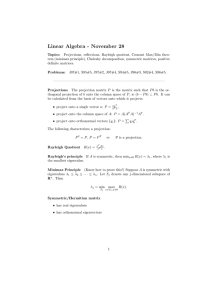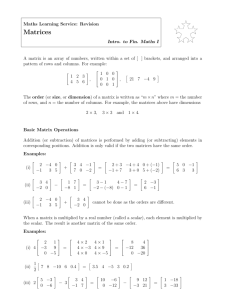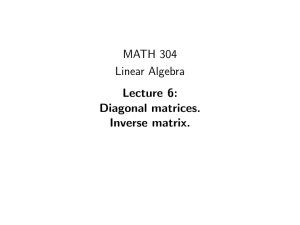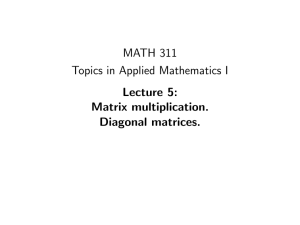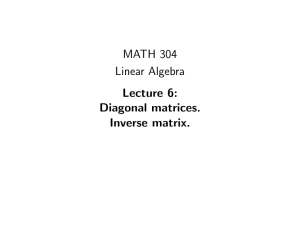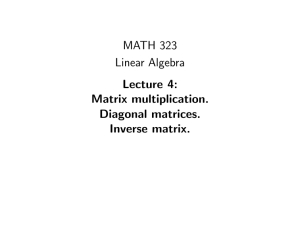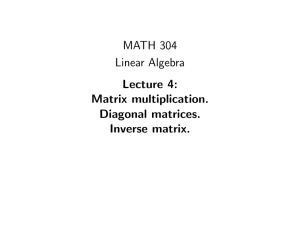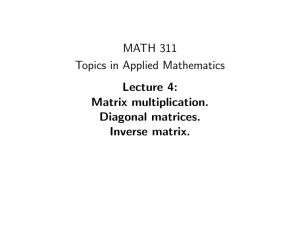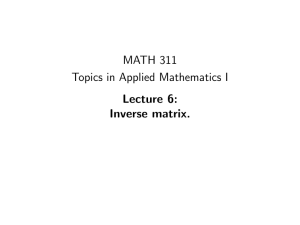MAXIMIZING THE DETERMINANT FOR A SPECIAL CLASS OF BLOCK-PARTITIONED MATRICES
advertisement
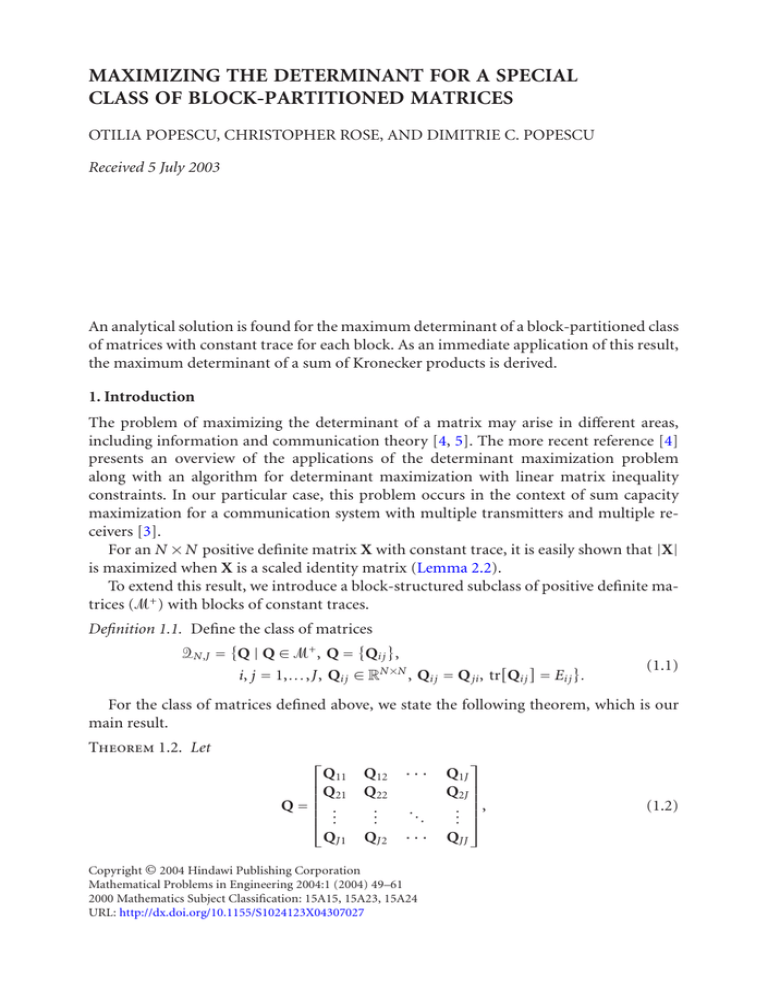
MAXIMIZING THE DETERMINANT FOR A SPECIAL
CLASS OF BLOCK-PARTITIONED MATRICES
OTILIA POPESCU, CHRISTOPHER ROSE, AND DIMITRIE C. POPESCU
Received 5 July 2003
An analytical solution is found for the maximum determinant of a block-partitioned class
of matrices with constant trace for each block. As an immediate application of this result,
the maximum determinant of a sum of Kronecker products is derived.
1. Introduction
The problem of maximizing the determinant of a matrix may arise in different areas,
including information and communication theory [4, 5]. The more recent reference [4]
presents an overview of the applications of the determinant maximization problem
along with an algorithm for determinant maximization with linear matrix inequality
constraints. In our particular case, this problem occurs in the context of sum capacity
maximization for a communication system with multiple transmitters and multiple receivers [3].
For an N × N positive definite matrix X with constant trace, it is easily shown that |X|
is maximized when X is a scaled identity matrix (Lemma 2.2).
To extend this result, we introduce a block-structured subclass of positive definite matrices (ᏹ+ ) with blocks of constant traces.
Definition 1.1. Define the class of matrices
ᏽN,J = Q | Q ∈ ᏹ+ , Q = Qi j ,
i, j = 1,...,J, Qi j ∈ RN ×N , Qi j = Q ji , tr Qi j = Ei j .
(1.1)
For the class of matrices defined above, we state the following theorem, which is our
main result.
Theorem 1.2. Let
Q21
Q=
...
Q12
Q22
..
.
···
QJ1
QJ2
···
Q11
..
Copyright © 2004 Hindawi Publishing Corporation
Mathematical Problems in Engineering 2004:1 (2004) 49–61
2000 Mathematics Subject Classification: 15A15, 15A23, 15A24
URL: http://dx.doi.org/10.1155/S1024123X04307027
.
Q1J
Q2J
,
..
.
QJJ
(1.2)
50
Determinant maximization for block-partitioned matrices
where Q ∈ ᏽN,J . Let the trace of each subblock be fixed and equal to tr[Qi j ] = Ei j . Then the
determinant of Q is maximized when each block is a scaled identity matrix of the form
Qi j =
Ei j
IN
N
(1.3)
and the maximum value of the determinant is
max |Q| =
Q∈ᏽN,J
1
|E|N ,
N NJ
(1.4)
where the elements of the square matrix E are {Ei j }.
2. Proof of the main result
We prove Theorem 1.2 by induction. First we prove the result for J = 2 and then show
that the result holds for J + 1 assuming that it holds for J.
2.1. J = 2. Let A and C be N × N positive definite matrices (∈ ᏹN+ ) with fixed traces EA
and EC , respectively. Let B be an N × N matrix with trace EB . Finally, we define Q ∈ ᏹ+ as
Q=
A B
.
B C
(2.1)
The matrix Q may be factored as
A 0
Q=
B I
I
A−1 B
0 C − BA−1 B
(2.2)
implying
|Q| = |A|C − BA−1 B .
(2.3)
The term Q/A ≡ C − BA−1 B is called Schur complement of A in Q [1] and it can be
easily shown that it is positive definite when Q is positive definite.
Lemma 2.1. If Q =
A B
B C
∈ ᏹ+ , then (C − BA−1 B ) ∈ ᏹ+ .
Proof. The matrix Q is positive definite. Therefore,
x1
x2
A
B
B C
x1
>0
x2
(2.4)
for all xi ∈ RN such that |x1 |2 + |x2 |2 > 0. Expanding, we have
x1 Ax1 + x2 Bx1 + x1 B x2 + x2 Cx2 > 0.
(2.5)
Otilia Popescu et al.
51
If we let x1 = −A−1 B x2 , we have
x2 Cx2 − x2 BA−1 B x2 = x2 C − BA−1 B x2 > 0
(2.6)
for all x2 ∈ RN , which implies (C − BA−1 B ) ∈ ᏹ+ and completes the proof.
Another important result is the following lemma.
Lemma 2.2. For any n × n positive definite matrix X with constant trace tr[X] = α, the
determinant is maximized when X = (α/n)In .
Proof. Applying Hadamard inequality [1], the determinant of an n × n matrix X is maximized when the matrix is diagonal,
that is, eigenvalues of the matrix are the diagonal
elements. If a = (a1 ,a2 ,...,an ), i ai = α, is the vector of eigenvalues of X, from majorization theory [2], the vector a∗ = (α/n,α/n,...,α/n), with all elements equal, is majorized
by any other vector a. Also, a majorization
result says that if g is a continuous nonnegative
function on I ⊂ R, a function φ(x) = ni=1 g(xi ) is Schur-concave (convex) on I n if and
only if log
g is concave (convex) on I. In our case, logx is a concave function on R+ and
det(X) = ni=1 ai is a Schur-concave function and its maximum is attained for a∗ . Having
all eigenvalues equal is equivalent to saying that X is a scaled identity matrix, under its
trace constraint.
This lemma shows that the determinant of a matrix with constant trace is maximized
when the matrix is a scaled identity matrix. Maximizing the trace of the matrix implies that the determinant is absolutely maximized when the matrix is a scaled identity
matrix with maximum trace. Further more, if a positive definite matrix can be written
as the difference of two other positive definite matrices, X = X1 − X2 , it is obvious that
tr[X] is maximized when tr[X1 ] is maximized and tr[X2 ] is minimized. In our case, we
consider
X = C − BA−1 B .
(2.7)
Then we can say
max C − BA−1 B = max
A,C,B
A,C
N
1
tr[C] − min tr BA−1 B
B
N
.
(2.8)
We turn our attention to minimizing tr[BA−1 B ] in B. Consider that
BA−1 B = UDV ΨΩ−1 Ψ VDU ,
(2.9)
where A = ΨΩΨ is an eigendecomposition and B = UDV is the usual singular value
decomposition. We then have
tr BA−1 B = tr DV ΨΩ−1 Ψ VD = tr D2 P Ω−1 P
(2.10)
after defining V Ψ = P . This expression reduces to
tr D2 P Ω−1 P =
pi2j d 2j
ij
ωi
,
(2.11)
52
Determinant maximization for block-partitioned matrices
where pi j are the elements of matrix P. Since P is the product of two unitary matrices, it
is a unitary matrix itself so that
pi2j =
i
pi2j = 1.
(2.12)
j
So, the problem of minimizing tr[BA−1 B ] over all B becomes
min tr D2 P Ω−1 P = min
{ pi j },{di }
B
pi2j d 2j
ij
ωi
.
(2.13)
From (2.12), pi2j , j = 1,2,...,N, as well as pi2j , i = 1,2,...,N, can be considered as probability mass functions. Therefore, we can rewrite the optimization problem as
min
{ pi j },{di }
Ei d 2
,
(2.14)
pi2j d2j .
(2.15)
ωi
i
where
Ei d2 =
j
Assume for now that the d2j and the ωi are fixed and ordered from the smallest to the
largest. We first note that
d2j
(2.16)
d12 ≤ Ei [·] ≤ dN2 .
(2.17)
i
Ei d2 =
j
and
For the moment, imagine that one could choose any Ei [·] subject to the constraints of
(2.16) and (2.17). That is, the underlying structure of the Ei [·] as generated from squared
entries of a unitary matrix is ignored for the time being. We then note that if EN [·] = dN2 ,
we can always reduce tr[D2 P Ω−1 P] by reducing one of the other Ei [·] which multiplies another 1/ωi > 1/ωN by some amount and adding this amount to EN [·]. If no such
greater 1/ωi exists, then we can still increase EN [·] to its maximum with no penalty to
the objective. For completeness, please note that if EN [·] < dN2 , then the sum, constraint
on Ei [·] in (2.16) guarantees the existence of at least one Ei [·] from which mass can be
“borrowed.”
Thus, at the minimum, we will require EN [·] = dN2 . However, to do so implies that
pNN = 1 which implies that pN j = 0, j = N, and that piN = 0, i = N—further implying
that Ei [·] ≤ dN2 −1 , i < N. Proceeding recursively, we see that to minimize tr[D2 P Ω−1 P],
we will have
1,
i = j, j = 1,2,...,N,
pi j =
0, otherwise,
(2.18)
Otilia Popescu et al.
53
so that
min tr D2 P Ω−1 P = min
{d j }
B
d2
i
i
ωi
.
(2.19)
Equation (2.18) implies that the right singular basis set of B and the eigenvector matrix
of A should be identical, V = Ψ in (2.9), and that the singular values of B should be
ordered from the smallest to the largest magnitude if the eigenvalues of A are ordered
from the smallest to the largest. If B is symmetric, this condition is strengthened to B and
A sharing the same eigenvector matrix with the eigenvalues of B being identical to the
singular values.
Now, consider the optimization over the set {d j } of (2.19). To obtain constraints for
the optimization, consider that
tr[B] = tr UDV = tr DV U = tr[DP] = EB ,
(2.20)
where P is a unitary matrix obtained from the multiplication of two unitary matrices U
and V . For such a matrix, we must have
pi j pk j = δik
(2.21)
j
and we note for later use that no entry pi j can have magnitude larger than 1. Proceeding,
we have
tr[DP] =
di pii = EB .
(2.22)
i
Forming the auxiliary function for the optimization problem, we have
L(D) =
d2
i
i
ωi
+α
pii di − EB .
(2.23)
i
The cross partials are zero and the second partials are positive since all ωi > 0. So the
problem is convex with a unique minimum. At the extremal, we must have
di
α
= − pii ,
ωi
2
(2.24)
which implies
pii di = EB = −
i
where we define ρ2 =
2
i ωi pii .
α
α
ωi pii2 = − ρ2 ,
2 i
2
(2.25)
We then have
−
α EB
=
,
2 ρ2
(2.26)
54
Determinant maximization for block-partitioned matrices
which further results in
di EB
=
pii .
ωi ρ 2
(2.27)
Using this result, we reevaluate the objective
d2
i
i
ωi
=
EB E2
di pii = B2
2
ρ i
ρ
(2.28)
and we next seek to maximize ρ2 .
Now, consider that since | pi j | ≤ 1, we must have
ωi pii2 ≤
i
ωi = EA
(2.29)
i
with equality if and only if | pii | = 1. Furthermore, since pi j are obtained from the product
of two unitary matrices, setting all | pii | = 1 implies that all pii = 1 and thence that V U = I.
Therefore, the optimum B should be a symmetric matrix and the singular values di are
therefore the eigenvalues of B. The set of di should satisfy
di =
EB
ωi ,
EA
(2.30)
which implies that B is a scaled version of A,
B=
EB
A,
EA
(2.31)
since we have already determined that V = Ψ. The minimum trace is then
−1
min tr BA B
B
EB2
EB2
.
= tr
2A =
EA
EA
(2.32)
We summarize the result as a theorem.
Theorem 2.3. Given two square N × N matrices, A ∈ ᏹ+ with tr[A] = EA , and B with
tr[B] = EB , the minimum of tr[BA−1 B ] in B is achieved when B is a scaled version of A,
B = (EB /EA )A, and
min tr BA−1 B =
B
EB2
.
EA
(2.33)
Returning to the original determinant maximization problem, we now have
max |Q| = max +
Q∈ᏽN,2
A,C∈ᏹN
or
max |Q| = max+
Q∈ᏽN,2
A∈ᏹN
EB2 |A|C − 2 A
EA EB2 |A| max+ C − 2 A .
EA C∈ᏹN (2.34)
(2.35)
Otilia Popescu et al.
55
We note that C − (EB2 /EA2 )A ∈ ᏹ+ , which implies that C = (EB2 /EA2 )A + X where X ∈ ᏹ+ .
Therefore, we can always choose the optimum C such that X = C − (EB2 /EA2 )A is a scaled
identity matrix. This implies that the inner maximization does not depend on the shape
of A and that we can choose A as a scaled identity matrix to maximize |A| in the outer
maximization. This in turn makes B and the optimal C scaled identity matrices as well.
So,
N
1 EA EC − EB2
N 2N
max |Q| =
Q∈ᏽN,2
(2.36)
and this maximum can be achieved when A, B, and C are all scaled identity matrices. We
summarize this result as a theorem.
Theorem 2.4. Let
A B
B C
(2.37)
be a positive definite matrix and let B be an N × N matrix. Under the constraints tr[A] = EA ,
tr[C] = EC , and tr[B] = EB ,
A
B
EA IN
B ≤N
C EB I
N
N
EB IN N = 1 EA EC − E2 N
B
EC N 2N
IN N
(2.38)
with equality when the matrices A, C, and B are all scaled identity matrices. If
EA
E=
EB
then
A
max B
EB
,
EC
(2.39)
B 1
=
|E|N .
C N 2N
(2.40)
2.2. The recursive extension for J > 2. Let Q be as defined in Theorem 1.2. Let the trace
constraints of the subblocks be tr[Qi j ] = Ei j and let E be the J × J matrix containing these
traces. Following an inductive line of reasoning, we assume that
max |Q| =
1
|E|N
N NJ
(2.41)
when all the submatrices of Q are scaled identity matrices. Now we seek to prove the
result for J + 1.
So, define X ∈ ᏽN,(J+1) as
A
B
1
X=
..
.
BJ
B1
···
Q
BJ
.
(2.42)
56
Determinant maximization for block-partitioned matrices
We then have
B1
BJ
,
.
. −1 B
|X| = |A|
1
Q − . A
···
(2.43)
BJ
which we rewrite as
|X| = |A||Q − Z|,
where
(2.44)
B1
. −1
B1
Z = ..
A
BJ .
···
(2.45)
BJ
Now, we know that Z ∈ ᏹ0+ by Lemma 2.1, and we also know that it has rank at most
N. We may therefore rewrite it as
Ω 0 ···
0
Z = u ū
..
.
0
0
0
u
ū ,
(2.46)
where u is an orthonormal basis which spans the column space of
B1
.
..
(2.47)
BJ
and ū is its complement such that
u u ū = I
ū
(2.48)
and Ω ∈ ᏹ0+ is an N × N diagonal matrix with tr[Z] = tr[Ω].
Now, consider that
u
|Q − Z| = (Q − Z) u
ū
u Qu − Ω
ū =
ū Qu
u Qū
,
ū Qū
(2.49)
which we can reduce to
|Q − Z| = ū Qū|H − Ω|,
(2.50)
where
H = u Qu − u Qū ū Qū
and H ∈ ᏹ+ .
−1
ū Qu
(2.51)
Otilia Popescu et al.
57
We can write Ω = αΘ, where α ≥ 0 and Θ ∈ ᏹ0+ has unit trace. Then we have
|H − Ω| = |H|I − αH−1/2 ΘH−1/2 = |H||I − αΛ|,
(2.52)
H−1/2 ΘH−1/2 = ΨΛΨ .
(2.53)
where
Now, for any given Λ (and therefore any given H and Θ), reducing α will strictly
increase the determinant in (2.52) since (I − αΛ) ∈ ᏹ+ . Thus, for |X| in (2.42) to be
maximized, we must have α minimized.
Proceeding, we have α = tr[Ω] = tr[Z]. Expanding tr[Z], we have
tr Bi A−1 Bi ,
tr[Z] =
(2.54)
i
and from Theorem 2.3, we know that tr[Z] may be minimized when each Bi is a scaled
version of A. Defining tr[Bi ] = βi , at this minimum, we have
β1 I
. .
Z=
. A β1 I
···
βJ I
(2.55)
βJ I
so that
Ω=
2
i βi
tr[A]
A
= α∗ Θ,
tr[A]
(2.56)
where
∗
α =
2
i βi
tr[A]
(2.57)
is the minimum possible trace of Z and
Θ=
A
.
tr[A]
(2.58)
If Θ ∈ ᏹ+ and α > α∗ , then we can choose A = tr[A]Θ and increase |H − αΘ| by
replacing α with α∗ . Thus, for all Θ ∈ ᏹ+ , we must have minimum trace Z if |Q − Z|
is maximized. However, if Θ ∈ ᏹ0+ and α > α∗ , then we cannot choose A directly since
A ∈ ᏹ+ . In this case, we can form
2
i βi
tr[A]
A
= α∗ Θ + F,
tr[A]
(2.59)
where F is a symmetric matrix with tr[F] = 0 which makes αΘ + F ∈ ᏹ+ for 0 < < .
We now show that replacement of αΘ by α∗ Θ + F can always increase |H − αΘ| for
suitably small .
58
Determinant maximization for block-partitioned matrices
First we expand
|H − αΘ − F| = |H − αΘ|I − (H − αΘ)−1/2 F(H − αΘ)−1/2 N
(2.60)
1 − νi ,
= |H − αΘ|
i=1
where the {νi } are the eigenvalues of (H − αΘ)−1/2 F(H − αΘ)−1/2 . Since
a continuous function in and
N
N
1 − νi |=0 = 1,
i=1 (1 − νi )
is
(2.61)
i=1
N
i=1 (1 − νi )
can be made arbitrarily close to 1. That is,
|H − αΘ| − δ ≤ |H − αΘ − F| ≤ |H − αΘ| + δ
(2.62)
for any δ > 0 through suitable choice of .
Now, since reduction of α strictly increases |H − αΘ|, we have
|H − αΘ| < H − α∗ Θ,
(2.63)
and for suitably small δ > 0, we also have
H − α∗ Θ − δ ≤ H − α∗ Θ − F ≤ H − α∗ Θ + δ.
(2.64)
So |H − αΘ| can always be strictly increased if α > α∗ .
Therefore, if there exist some Θ∗ and Q∗ which ostensibly minimize |Q − Z|, then
unless tr[Z] is minimized, this “maximum” could be further increased—a contradiction.
Therefore, for |Q − Z| to be maximized, α = tr[Z] must be minimized.
With tr[Z] minimized, we have
Zi j = βi β j
tr[A]
tr Zi j =
2 A,
βi β j
.
tr[A]
(2.65)
Since (Q − Z) ∈ ᏽN,J , we obtain by the assumption for J that
β12
E11 −
tr[A]
β1 β2
1 E21 − tr[A]
|Q − Z| ≤ NJ N ..
.
ββ
EJ1 − 1 J
tr[A]
β1 β2
E12 −
tr[A]
β2
E22 − 2
tr[A]
···
..
···
.
···
β1 βJ E1J −
tr[A] ..
.
.
βJ2 EJJ −
tr[A] ..
.
(2.66)
Otilia Popescu et al.
59
From Theorem 2.3, we note that at the minimum trace point, tr[Zi j ] does not depend
on the spectral shape of A, but on its trace only. Therefore, once we have chosen Bi to
minimize tr[Z] and thereby allow the maximum value of |Q − Z|, we are free to choose
the shape of A. Since choosing A = (tr[A]/N)I maximizes |A|, we then have
β12
E11 −
tr[A]
β1 β2
tr[A]N 1 E21 − tr[A]
max |X| ≤
N N N NJ ..
.
ββ
EJ1 − 1 J
β1 β2
E12 −
tr[A]
β2
E22 − 2
tr[A]
N
···
..
···
tr[A]
β1 βJ E1J −
tr[A] ..
.
βJ2 EJJ −
tr[A] ..
.
.
···
(2.67)
with equality when all the submatrices of X are scaled identity matrices.
If we note that
tr[A]
β
1
β2
.
.
.
β
J
β1
E11
β2
E12
βJ E1J .. . .. . EJJ ···
···
E21
..
EJ1
.
···
E
11
E21
= tr[A] .
..
EJ1
···
E12
E22
···
..
EJ2
β12
E11 −
tr[A]
E21 − β1 β2
tr[A]
= tr[A] ..
.
ββ
EJ1 − 1 J
tr[A]
.
···
E1J
β
1
E2J
β2 1
β1
−
.
..
. .. tr[A]
EJJ
β1 β2
E12 −
tr[A]
β2
E22 − 2
tr[A]
βJ
(2.68)
···
..
···
···
β2
βJ .
···
β1 βJ E1J −
tr[A] ..
.
,
βJ2 EJJ −
tr[A] ..
.
then, when all blocks in X are scaled identity matrices, we have
tr[A]
β1
1 |X| = N(J+1) β2
N
.
.
.
βJ
β1
E11
···
E12
E21
EJ1
···
···
..
···
.
···
N
βJ E1J .. . ,
.. . EJJ which proves the (J + 1) case, and through induction completes the proof.
(2.69)
60
Determinant maximization for block-partitioned matrices
3. Application to maximum determinant of a sum of Kronecker products
Given two matrices A ∈ RB×B fixed and X ∈ RN ×N with constant trace tr[X] = α, the
determinant of their Kronecker product R = A ⊗ X is given by
|R| = |A|N |X|B .
(3.1)
Since |A| is assumed constant, in order to maximize |R|, we need to maximize |X|, and
under the trace constraint, this is done when X = (α/N)IN (Lemma 2.2).
Considering now a sum of Kronecker products,
R=
L
Ak ⊗ Xk = Ri j ,
Ri j =
k=1
L
ak (i, j)Xk , i, j = 1,...,L,
(3.2)
k=1
where we assume that Ak = [ak (i, j)] are B × B symmetric constant matrices and Xk are
N × N symmetric matrix with constant trace, tr[Xk ] = αk . To satisfy the conditions of
Theorem 1.2, we require that R be a positive definite matrix and that all blocks on the
main diagonal, Rii , be also positive definite matrices. Such matrices appear in the context
of capacity maximization for multibase communication systems [3]. Thus, the matrix R
belongs to the class ᏽN,B and the associated matrix of traces E has elements
Ei j =
L
ak (i, j)αk .
(3.3)
k=1
As a direct application of Theorem 1.2 to matrix R, we have the following corollary.
Corollary 3.1. The determinant of a sum of Kronecker products, as described above, is
maximized when the whole sum is equal to a single Kronecker product between the trace
matrix and an identity matrix. Thus, maximum det(R) is achieved when
R=
L
Ak ⊗ Xk = E ⊗ IN .
(3.4)
k=1
If we are interested in finding the set of matrices {Xk } that maximize det(R), we note
that (3.4) is equivalent (because of its symmetry) to a linear system with B(B + 1)/2 equations and L unknowns:
L
ak (i, j)Xk = Ei j ,
i = 1,...,B, j ≥ i.
(3.5)
k=1
Depending on the relative magnitudes of B and L, this system might have one or more
solutions, but one of these solutions is always Xk = (αk /N)IN .
Otilia Popescu et al.
61
References
[1]
[2]
[3]
[4]
[5]
R. A. Horn and C. R. Johnson, Matrix Analysis, Cambridge University Press, Cambridge, 1985.
A. W. Marshall and I. Olkin, Inequalities: Theory of Majorization and Its Applications, Mathematics in Science and Engineering, vol. 143, Academic Press, New York, 1979.
O. Popescu and C. Rose, Interference avoidance and sum capacity for multibase systems, Proceedings 39th Allerton Conference on Communication, Control, and Computing (Monticello,
Ill), University of Illinois at Urbana-Champaign, Illinois, 2001, pp. 1036–1049.
L. Vandenberghe, S. Boyd, and S.-P. Wu, Determinant maximization with linear matrix inequality constraints, SIAM J. Matrix Anal. Appl. 19 (1998), no. 2, 499–533.
H. S. Witsenhausen, A determinant maximization problem occurring in the theory of data communication, SIAM J. Appl. Math. 29 (1975), no. 3, 515–522.
Otilia Popescu: WINLAB, Rutgers University, 73 Brett Road, Piscataway, NJ 08854-8058, USA
E-mail address: otilia@winlab.rutgers.edu
Christopher Rose: WINLAB, Rutgers University, 73 Brett Road, Piscataway, NJ 08854-8058, USA
E-mail address: crose@winlab.rutgers.edu
Dimitrie C. Popescu: Department of Electrical Engineering, University of Texas at San Antonio,
6900 North Loop 1604 West, San Antonio, TX 78249-0669, USA
E-mail address: dpopescu@utsa.edu
